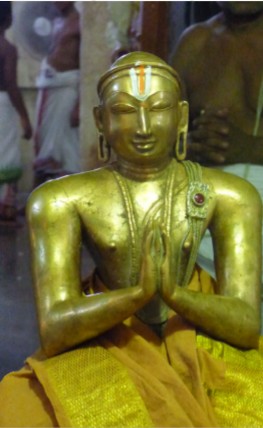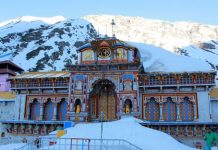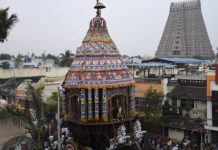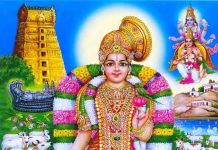Swami Alavandhar of Kanchipuram
Bhaghavadh Ramanuja
Meanwhile at Srirangam Alavandar was getting old and infirm. Some srivaishnavas from Kanchipuram who had come to Srirangam came to see swami and he enquired about Sri Ramanuja. They told him about the happenings at Kanchi. Extremely happy he thanked Varadan for answering his prayers and immediately sent for Mahapoorna(Periya nambi). He asked him to go to Kanchi and fetch Ramanuja. Mahapoorna immediately left Srirangam and reached Kanchipuram in a couple of days. After worshipping Perundevi Thayar and Perarulalan he told Kanchi poorna (Tirukacchi nambi) about Alavandar’s health and his wish to see Ramanuja. He waited at the path Ramanuja took while fetching water from the ‘salai-kinaru’ and recited Sri Alavandar’s ‘stotra-ratnam’. On hearing the exquisite words Ramanuja wanted to know the creator of these priceless stotrams. Periya nambi told him about Alavandar and Ramanuja expressed his desire to have darshan of this mahaan. After taking leave of Perundevi Thayar and Varadan, Ramanuja followed Periya nambi to Srirangam. As they reached the banks of Kollidam news of Alavandar’s Paramapadaprapthi (shedding his mortal koils) was heard. Ramanuja was devastated. Periya nambi consoled him and they went to see Alavandar’s carama tirumeni (mortal remains). Ramanuja noticed that three fingers were folded and asked people around whether it was always like this. His shishyas then told Ramanuja about Alavandar’s longing to see him and the three desires swami had.
Alavandar’s three wishes:
First wish was for a bashyam (commentary) on Brahmasutram.
Second wish was to show gratitude to Vyasa maharsi and Parasara maharsi for establishing the supremacy of Sriman Narayana by naming two srivaishnava children after them.
Third wish was for a bashyam on Nammazhwar’s Tiruvaymozhi.
Holding his hands up Ramanuja pledged that by the grace of Varadaraja Perumal he would fulfil his guru’s wishes. The three fingers opened up and the srivaishnavas hailed Sri Ramanuja as the ‘darsana sthapakar’. Ramanuja then left Srirangam for Kanchipuram.
Thirukachi nambigal -Poovirundavalli
Tirukacchi nambi-Mylapore
The Six Truths
At Kanchipuram Ramanuja asked Tirukacchi nambi who did ‘alavatta kainkaryam’ (fanning services) to Varadaraja Perumal to pose some queries to Varadan. Incidentally Varadaraja Perumal used to talk to Kanchi poorna(Tirukacchi nambi) when he offered fanning services. This mahaan used to travel all the way from Ponthamalee in Chennai to Kanchipuram to offer aalavattam services (fanning Perumal with a hand fan). At that time Varadan used to talk to Kanchipoorna. So at Ramanuja’s behest Kanchipoorna put forward Ramanuja’s questions and conveyed the Six Truths to Ramanuja.
1) ‘Ahameva Paratatvam’ (Perumal and Piratti constitute The Supreme)
2) ‘Darsanam Bheda evam cha’ (Paramatma and jeevatma exist as different entities.)
3) ‘Upaayethi Prappathi’ (Saranagathi is the Means to attain Him)
4) ‘Antima smrithi varjanam’ (Rembering Him at the last moment of life is excused for a prappanan)
5) ‘Dehavasane Mukthisyaath’ (Moksham will be attained at the end of one’s lifespan)
6) ‘Poornacharya Samashraye’ (Get panchasamskaram from Periya nam
Aaru vaarthai malai
Ramanuja was elated on hearing this and after worshipping Perarulalan and Perundevi Thayar Ramanuja set out to seek Mahapoorna (Periya nambi). Meanwhile at Srirangam the srivaishnavas urged Periyanambi to bring Ramanuja to Srirangam and make him the Darsana pravarthakar of our sampradaya as per Swami Alavandar’s wishes. So Mahapoorna (Periya nambi) set forth on his mission accompanied by his devigal (wife). They worshipped at several divyadesams enroute and reached Madurantakam.
Swami Ramanuja and His Acharyan Sri Periya Nambi
The Mantapam where Swami Ramanuja had His Pancha Samskaram
The Vakula(Mazhiya maram) Tree
At this point we have to digress to talk about the glory of Madurantakam. Madurantakam is a small town near Chingelpet which is famous for its yeri (lake) and yerikaatha Rama (Rama who guarded the lake). Our story goes back to the 18th century when we were ruled by the British. An Englishman by name Lionel Place was the collector of Madurantakam at that time. It was the monsoons and the rains were pouring relentlessly making the water-level rise alarmingly. The collector was told about Sri Rama and His prowess. Although sceptical he said half in jest that if their Rama did Protect the town from flooding he would renovate the sannidhi for Rama’s beloved wife Janakavalli. Even as he was watching the waters rising alarmingly he beheld two handsome celestials bow in hand near the lake and automatically knelt down and prayed to Them. The water miraculously stopped rising and construction for Seetha’s sannidhi started the very next day. This Rama thus saved the ‘yeri’ and the ‘durai’. This Rama came to be known as ‘yeri kaartha Rama’ (The Rama who protected temple.
Getting back to our Ramanuja’s association with this town ……
Ramanujacharya as instructed by Kanchi poorna (Tirukacchi nambi) left Kanchipuram for Srirangam seeking Mahapoorna (Periya nambi). On the way he stopped at Madurantakam and was surprised to find Mahapoorna and his devigal there. Madurantakam used to be known as Vakularanyam as it was filled with vakula (mazhiyam) trees. Mazhiyam flowers are a favourite of Nammazhwar. Ramanuja did Dandavath pranams (sahstangam) to Periya nambi and his devigal and informed them about Varadan’s command. Ramanuja begged for samashrayanam and mantropadesam. Samashrayanam means approaching an acharyan. It is also known as ‘pancha samskaram’ or five-fold purifactory rites. The five samskaras are
1) Thaapam - Silver emblems of the sankhu (Panchajanyam) and chakram (Sudarshanam) are heated and embossed on the arms just below the shoulders by a sadhacharyan.
2) Pundrams - Acharyan symbolically applies dwadasa urdhvapundrams (12 Tirumans) for men at specific spots and Srichoornam and tiruman between the eyebrows for women with a silver tiruman stick.
3) Dasyanamam - Men become Ramanujadasas and women Ramanujadasis heneforth. Ramanuja became Alavandardasan.
4) Mantra upadesams - SriAshtaskaram, Dwayam, Charama slokam are initiated. After this the initiated are supposed to do mantra japams daily.
5) Tiruaradhana kramam, Ramayana and Bhaghavadh Geetha upadesham - Men are initiated into the method of daily worship (Tiruvaradhana kramam) and are asked to repeat the beginning slokams of Srimadh Ramayana and Srimadh Bhaghavadh Geetha etc.
Acharya thanians that is specific slokas for acharyas are initiated.
Now to come back to our story Ramanujacharya requested Periya nambi for samashrayanam. Periya nambi said they could go to Kanchipuram and do the needful. With folded hands Sri Ramanujacharya pleaded that he did not want to postpone it for after his missing Alavandar darsanam he vowed not to procrastinate in such matters. So Periya nambi and Ramanuja offered dandavath pranams at the sannidhis of Janakavalli Thayar and Rama and then Periyanambi performed ‘Pancha samskarams’ for Ramanujacharya under the shade of a Vakula tree (Mazhiya maram). Behind Andal sannidhi in the temple a platform has been raised under the Vakula tree and there is a wall painting depicting the panchasamskara ceremony. Every year on Avani Sukla Panchami day ‘Pancha samskara utsavam’ is celebrated commemorating this event . Ramanuja is seen in white veshti in this kshetram as he was a grihasthan at that point of time. Ramanuja returned to Kanchipuram along with his guru and his devigal. He requested Periyanambi and his devigal to stay in his house in Kanchipuram and allocated a portion to them. He studied Vyasa sutras and divyaprabhandhams except Tiruvaymozhi at the feet of Periyanambi. So far we have seen Alavandar Ramanuja’s maanasika guru, Kanchipoorna or Tirukacchinambi who revealed the ‘Six Truths’ and Mahapoorna or Periya nambi his samashrayana acharya. In the next part we shall explore further into the life of Sri Ramanujacharya.
(To be continued)
Courtesy: Smt Vyjayanthi Rajan



















Namaskaram… Thank you for such a detailed and dedicated service… Keep up the good service.
Uthra Krishnan
Thank you for your kind words.